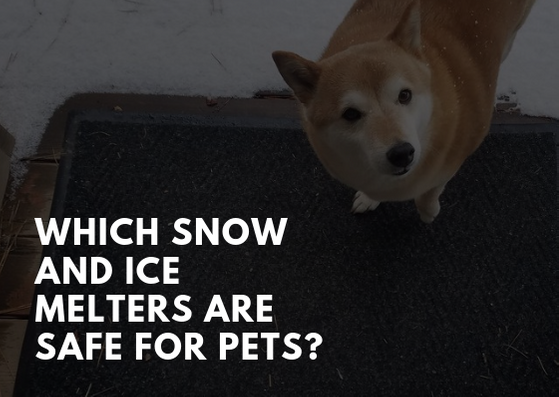 As pet owners, we want to keep our pets safe and happy year-round. Winter can be a challenging time for our four-legged loved ones as snow, and the products used to manage it, can make the outdoors unpleasant and even unsafe.
As pet owners, we want to keep our pets safe and happy year-round. Winter can be a challenging time for our four-legged loved ones as snow, and the products used to manage it, can make the outdoors unpleasant and even unsafe.
It’s common to use snow- and ice-melt products around the outside and on entryways to homes to ensure the safety of these areas during the winter months. Unless you’re planning on putting booties on your dog or cat each time he or she goes outside, it’s an inevitability that their paws are going to come into contact with whatever product has been spread to keep snow and ice at bay.
The result of coming in contact with these chemicals can be irritation and/or dryness of paws and skin, irritation to the mouth if pets eat the products or drink runoff, and even poisoning if enough is consumed.
The good news is that there are some alternative options to the more commonly used snow and ice melters that are considered safe for pets.
Pet-Safe Snow- and Ice-Melt Products
There are snow- and ice-melt products that are specifically marketed as pet-safe, and a simple search of the internet will turn up several. While it’s encouraging that these products exist, some of them are fairly expensive and less effective, such as those that contain urea as a main ingredient. As well, some of the “pet-safe” ice-melt products are, in fact, safer for pets’ paws but are still highly toxic if consumed, as with ethylene glycol-based ice melts that contain the same active ingredient as antifreeze.
Referring to pets in general in the context of product safety can also be misleading. Ice-melt products that are propylene glycol-based are very safe for dogs but are harmful to cats, for example. Similarly, depending on your definition of “pet,” these products, which often contain urea and are safe for dogs and cats, can be dangerous for cows and goats.
Green Alternatives
There are some eco-friendly ice-melt alternatives that are also pet-safe. These include:
- Sugar beet juice- Sugar acts in a similar fashion as salt and lowers the freezing temperature of water. This increasingly popular snow- and ice-melt option may not be as effective at lower temperatures, however, and can leave behind a sugary pest-attracting residue.
- Coffee grounds- This surprising alternative works by absorbing light and heat thus melting snow and ice. If ground coarsely, coffee grounds can also provide extra traction and safety. Unfortunately, staining of underlying surfaces can occur and, while this is a safer option for pets, it could be a messy option when tracked indoors. The effects of caffeine consumption on pets if paws are licked clean is also somewhat of an unknown with this choice.
- Alfalfa meal- This is a commonly-used fertilizer that melts snow and ice. It’s also used for animal feed so it’s obviously safe if consumed by pets, although this can also make it attractive to unwanted guests like rodents and other wildlife. Its grainy texture also provides extra traction.
DIY Pet-Safe Snow- and Ice-Melt
Combining one teaspoon of Dawn dish soap (this brand is most effective) and one tablespoon of rubbing alcohol in half a gallon of warm water will produce a pet-safe ice-melt that can be sprayed or poured on surfaces. This is a less expensive alternative to pet-safe ice-melt products and can both melt existing ice as well as prevent more from forming during snowfall.
While dish soap and rubbing alcohol aren’t ideal ingredients for your pets’ diets, they’re dilute enough in this DIY recipe that they shouldn’t have an impact on their digestive system if ingested, particularly when further diluted with melted snow. Wiping pets’ paws when they come inside is a good way to manage this concern.
Other Tips to Consider
- As we mentioned earlier, booties are a less convenient but potential option for at least protecting paws. Drawbacks to this alternative are that cats won’t typically wear them and they don’t safeguard against possible ingestion.
- Products such as paw wax or Bag Balm can also help protect pets’ paws, but again, don’t keep pets safe from ingesting potentially harmful products.
- If you are going to purchase an ice-melt product marketed as pet-safe, look for one without warning labels. If it isn’t safe for you or your kids, it’s likely not safe for your pets.
- Avoid safety concerns and messes completely and consider an alternative option to snow- and ice-melters such as heated snow-melting mats. These mats are safe for pets, have tread providing extra traction and safety, are energy efficient and, after being placed and plugged in, don’t require ongoing maintenance.


